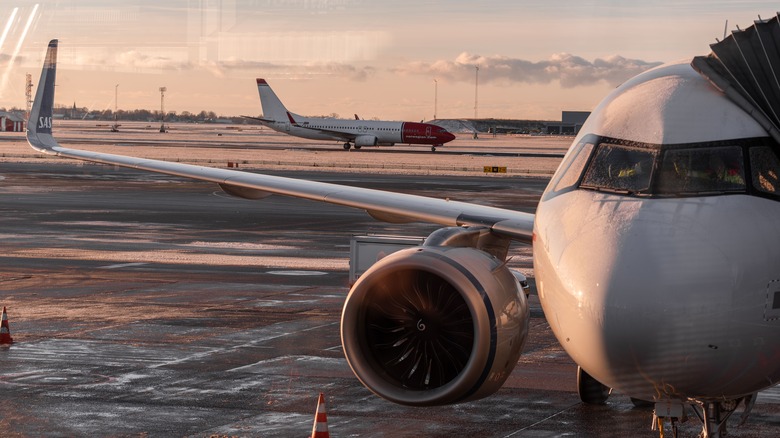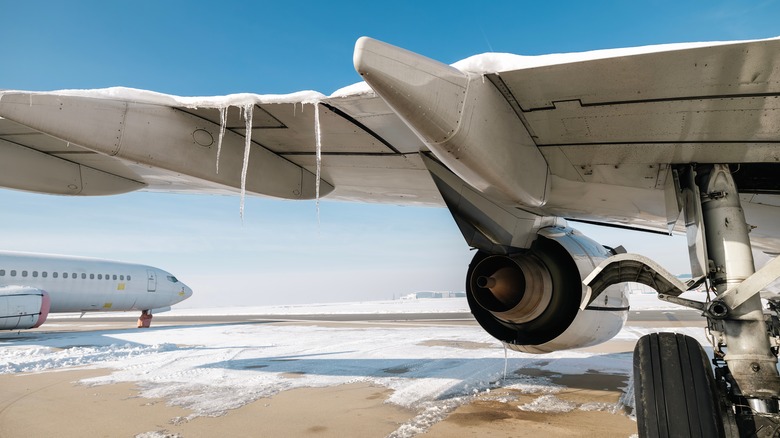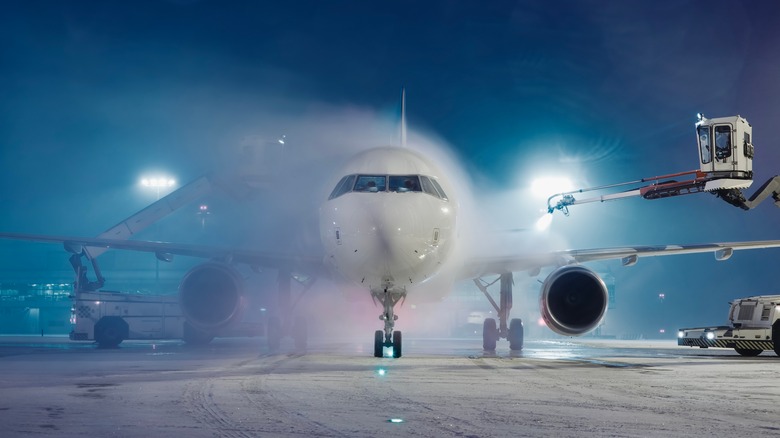The Dangerous Side Of Frost That Could Impact Your Next Flight
While no one particularly enjoys thinking about what might go wrong during their travels, the hard truth is that understanding certain safety procedures can actually help put your mind at ease in the long-run. After all, knowledge truly is power — especially when you're sitting in your seat, wondering about that strange airplane noise or asking yourself why the plane seems to be taking a little longer than usual to take off.
The thing is, you've probably even picked up various travel safety tips over the years without even noticing them. From accidentally learning what those specific overhead chimes really mean on a plane to picking up on the cruise ship code words you'll want to keep your ears peeled for, travel safety is almost second nature to some. However, in between the emergency protocols and must-do's, there's actually one specific winter travel concern that you might not have considered before: frost.
After all, this seemingly innocent coating of ice crystals — you know, the same stuff that makes your lawn sparkle on a cold morning — can actually pose significant challenges for an aircraft. Specifically, challenges that can affect the plane's weight and ability to fly properly — two things you definitely don't want to mess with.
Frost can affect a plane's overall performance
Sure, you might think that a light dusting of frost is no big deal. After all, how much damage can something barely thicker than sandpaper really do? Well, according to a 2016 study by NASA, even a barely-there, thin layer of frost can ultimately reduce a plane's lift by up to 30%. This, because airplane wings aren't just random sheets of metal — they're precisely designed to get a massive hunk of metal off the ground. So, when frost shows up, it basically ruins all of that careful engineering by adding up to a whole rhinoceros' worth of weight to the aircraft.
However, frost concerns aren't just about the extra weight. The problem also comes from how frost messes with the way air moves over the wings — disrupting the precise airflow that's needed for a proper, safe lift. Basically, think of it like trying to glide smoothly versus fighting against a strong current. At the end of the day, that tiny layer of frost can create an unpleasant situation that can, if not handled properly and timely, seriously impact how well those wings do their very important job of keeping you (and all those other passengers and crew members) in the air.
How to deal with frost on an airplane
Thankfully, it's actually very rare that your plane will ever take off before being properly inspected and cleared for frost — or any other issue, for that matter. Before every flight in cold conditions, pilots and ground crews must follow a strict inspection routine that includes everything from physically walking around the aircraft to checking every surface and climbing up on tall ladders to inspect even the hardest-to-reach spots like the tail. In fact, crews will even peek through the cabin windows to examine the wings from different angles, all to make sure that no sneaky ice patches are hiding anywhere out of sight.
Once the inspection is done, the crew can then decide on how to proceed with the appropriate process — and, from mechanical de-icing to storing planes in heated hangars, there are plenty of ways to tackle the frost problem. This process is exactly why you might find yourself sitting on the tarmac during a wintertime holiday, watching the ground crew closely as they spray a mysterious orange fluid all over your plane. Turns out, there's nothing that mysterious or scary about it: It's just a heated glycol-based solution that'll melt away existing frost and prevent new ice from forming for about 30 minutes. And while this de-icing process might delay your flight — especially because planes sometimes need multiple sprays if the weather's particularly nasty — it's always better to be safe than sorry when it comes to dealing with the possibility of dangerous frost.


